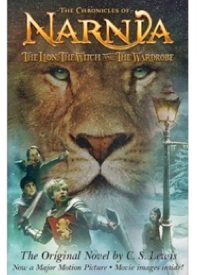
The Chronicles of Narnia, by C.S. Lewis, is a treasure trove of timeless Christian truths able to edify, enlighten, educate, and entertain both children and adults alike.
Christian theologian and author C.S. Lewis made his first foray into children’s literature in 1950 with The Lion, the Witch, and the Wardrobe, a beautiful tale, suffused with rich Christian imagery, about the adventures of four English children who find themselves involved in a fight between the timeless forces of good and evil in the magical land of Narnia. Narnia is in the thrall of the White Witch, an evil sorceress who has created perpetual winter in the once-verdant land, enslaving its inhabitants and turning many of them to stone. The arrival of the four children sparks a revolt among the Narnians, who have been told that when Sons of Adam and Daughters of Eve appear in Narnia, the magical Lion Aslan will return to overthrow the forces of evil.
One of the four children, impetuous Edmund, is deceived by the White Witch, however, and betrays his friends, who must flee to escape capture. Fortunately, the Lion Aslan makes his appearance in time to rally the forces of good. But there’s a catch: The wily White Witch informs Aslan that she will not relinquish her claim on young Edmund, who by law must die for his act of betrayal. Aslan then offers himself to the Witch in Edmund’s stead; she and her motley band of evil followers promptly bind Aslan with ropes, lay him on an altar, and kill him. The children spend a night weeping beside Aslan’s body, bereft of hope. But with the coming of dawn, mice chew apart the ropes still binding the Lion’s body, and he himself comes back to life. The stone altar where his body lay is broken in half, and the resurrected Aslan triumphantly leads the forces of good in a decisive rout of the witch and her hellish minions.
Fairy-tale Metaphors
This splendid allegory of Christ’s Atonement and Resurrection became wildly popular, prompting Lewis to write six more books in the Narnia series, all of which use fairy-tale metaphors to explore Christian themes. Through all seven volumes, the colossal Christ-figure of Aslan is the dominant presence, guiding the heroes and heroines to decisive, miraculous outcomes while holding evil in check. In The Voyage of the Dawn Treader, the heroes travel to “the Very End of the World.” There they encounter Aslan, who — in a scene recalling John 21, where the disciples meet the resurrected Christ at the sea of Tiberias — appears as a Lamb sitting near the seashore beside a fire where some fish are roasting. Upon being informed that they will never return to Narnia, the children ask Aslan if they can ever see him again in their own world:
“What!” said Edmund. “Is there a way into Aslan’s country from our world too?”
“There is a way into my country from all the worlds,” said the Lamb….
“Are — are you [in our world] too, Sir?” said Edmund.
“I am,” said Aslan. “But there I have another name. You must learn to know me by that name. This was the very reason why you were brought to Narnia, that by knowing me here for a little, you may know me better there.”
The final two Narnia books written by Lewis chronicle the story of both the creation of Narnia and its end. The Magician’s Nephew tells of a group of awestruck children from Earth who watch as Aslan creates Narnia, first causing light to appear over a dark and desolate landscape and then causing plants and animals to spring from the dust. Unfortunately, one of the children has accidentally brought to Narnia the evil enchantress Jadis, who flees into the woods after an unsuccessful attack on Aslan. The Lion, knowing that Jadis will eventually cause trouble in Narnia as the White Witch, sends the boy to fetch an apple from a tree from a beautiful garden high in the mountains. A tree from the apple’s seeds will act as a protector of Narnia for many centuries. But on arriving at the secluded garden, the boy finds the evil Jadis already there. She tempts him to eat the fruit himself, which, she explains, will confer immortality not only on him, but on his dying mother back in London. The boy ultimately refuses and brings the apple back to Aslan.
The Last Battle
Unfortunately, even in Edenic Narnia, evil eventually takes over. The final book, The Last Battle, is perhaps the most powerful story of all. The book opens with a crafty ape, Shift, discovering a lion’s skin in a forest pool. Lusting for power, Shift persuades his gullible friend, the donkey Puzzle, to masquerade as Aslan by wearing the skin. In this way, Shift quickly gathers a large following and overthrows the legitimate ruler of Narnia, young King Tirian, enslaving the animals and inviting idolatrous foreigners to share in the booty.
The imprisoned King prays to Aslan, who sends him two children from Earth to help. They free the King and attempt to cause an uprising, but it is too late; many of the citizens of Narnia have become cynical and have lost their faith in Aslan. Even when the Antichrist-like Shift and his false lion are exposed, many Narnians conclude that Aslan was a sham to begin with. They encircle and defeat the dwindling army of King Tirian and, with the help of savage mercenaries from barbaric Calormen, begin tossing the survivors into a shed housing the idolatrous god Tash. The children are thrown inside, only to be shielded from Tash by Aslan.
The shed becomes a sort of portal, where the children and other Narnians watch as the Lion decrees the end of the world of Narnia. Father Time awakens and blows his horn, bringing about a darkening of the sun and a shower of stars. The moon turns blood red along with the waters of the sea, and the world of Narnia passes away. As Aslan stands at the portal, the denizens of Narnia file past, the unbelievers disappearing into the shadow on his left side, the faithful joining him in a beautiful meadow on his right side. Finally, all seven children who have figured in the Narnia series, along with heroes from all seven books, follow Aslan through Elysian meadows and hills to a new Narnia, one where evil has no place and which is connected with a new Earth and other paradisiacal realms as well. The children discover that, in fact, they have left the “Shadow-lands,” as Lewis terms mortal worlds, forever, having all “died” in a London train accident at the beginning of the book. They are overjoyed at the prospect of never again being separated from any of their loved ones, or from Aslan’s awesome presence and empyrean dominion.
The Narnia series has a timeless quality, due in no small measure to C.S. Lewis’ unstinting willingness to use his stories as vehicles for Christian theology. Their power to uplift as well as to entertain, unrivaled in children’s literature, make them genuinely worthy of inclusion in the home library of any Christian.
* * * * * * * * * * * *
The seven Narnia books are listed below, each title followed by a one-sentence description:
The Magician’s Nephew: A group of children from Earth witness the glorious creation of Narnia by the great Lion-king Aslan. But trouble, in the form of the evil enchantress Jadis, is not far away in this newly fashioned paradise.
The Lion, the Witch, and the Wardrobe: The evil White Witch holds Narnia in the frozen grip of perpetual winter, turning those who dare oppose her into stone. As for Peter, Susan, Edmund, and Lucy, four children from Earth who have made their way to Narnia, they can only hope that Aslan will return to defeat the White Witch.
The Horse and His Boy: A group of travelers seeking freedom in Narnia find their journey to be a race against time when they discover that the warlike land of Calormen is plotting the conquest of Narnia.
The Last Battle: An imposter is afoot in Narnia, and the inhabitants of that magic realm — believing the imposter to be Aslan — submit to his unjust decrees. It is the moment of Narnia’s greatest peril; will the real Aslan emerge triumphant?
Prince Caspian: Peter, Susan, Edmund, and Lucy are called back to Narnia from their homes in England by Prince Caspian, who seeks to reestablish liberty in the magical land created by Aslan.
The Silver Chair: Ten years ago Prince Rilian, the son of Caspian, disappeared. Now the great Aslan has sent two children, Eustace Scrub and Jill Pole, to find him.
The Voyage of the Dawn Treader: Edmund and Lucy join an expedition aboard the ship Dawn Treader as it sails toward the uncharted waters of the “utter East” in search of seven banished lords of Narnia and the home of the great Lion Aslan.
This article was originally published in the August 28, 2000 issue of The New American.
Related article:
Newest Chronicles of Narnia Film Depicts Christians’ Difficulties



